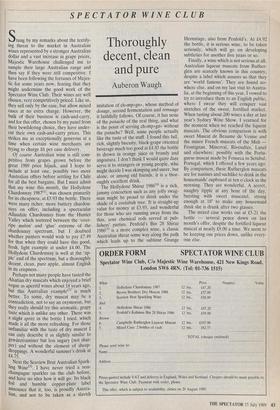SPECTATOR WINE CLUB
Thoroughly decent, clean and pure
Auberon Waugh
Stung by my remarks about the terrify- ing threat to the market in Australian wines represented by a stronger Australian dollar and a vast increase in grape prices, Majestic Warehouse challenged me to sample their large Australian range and then say if they were still competitive. I have been following the fortunes of Majes- tic for some years now, fearing that they might undermine the good work of the Spectator Wine Club. Their wines are well chosen, very competitively priced. Like us, they sell only by the case, but allow mixed cases at no extra charge. However, the bulk of their business is cash-and-carry, and for this offer, chosen by my panel from their bewildering choice, they have under- cut their own cash-and-carry prices. This strikes me as exceptionally generous at a time when certain wine merchants are trying to charge £6 per case delivery.
Of course Australian wine is still com- petitive from grapes grown before the great 1989 price hijack, and I hope to include at least one, possibly two more Australian offers before settling for Chile for all the best bargains. But I must admit that my wine this month, the Hollydene Chardonnay 1987(1), was chosen primarily for its cheapness, at £3.93 the bottle. There were many richer, more buttery chardon- nays on offer, including a spectacular Allandale Chardonnay from the Hunter Valley which teetered between the 'over- ripe melon' and 'glue' extreme of the chardonnay spectrum, but I doubted whether punters would wish to pay £7.49 for that when they could have this good, fresh, light example at under £4.00. The Hollydene Chardonnay is well at the 'ap- ple' end of the spectrum, but a thoroughly decent, clean, pure apple, almost English in its crispness.
Perhaps not many people have tasted the Alsatian dry muscats which enjoyed a brief vogue as aperitif wines about 18 years ago, but this Australian example(2) is much better. To some, dry muscat may be a contradiction, not to say an oxymoron, but they really should try this aromatic, grapy taste which is unlike any other. There was a slight spritz in the bottle I tried, which made it all the more refreshing. For those unfamiliar with the taste of dry muscat I can only describe it as slightly similar to gewurztraminer but less sugary (not shar- per) and without the element of sheep- droppings. A wonderful summer's drink at £4.75.
Next the Seaview Brut Australian Spark- ling Wine(3). I have never tried a non- champagne sparkler on the club before, and have no idea how it will go. Its black foil and humble copper-plate label announce that it, too, is proudly Austra- lian, and not to be taken as a slavish imitation of ch*mp*gn*, whose method of dosage, second fermentation and remuage it faithfully follows. Of course, it has none of the panache of the real thing, and what is the point of serving ch*mp*gn* without the panache? Well, some people actually like the taste of the stuff. I found this full, rich, slightly biscuity, black-grape oriented beverage much too good at £4.85 the bottle to drown in orange juice or brandy and angostura. I don't think I would quite dare serve it to strangers or young people, who might decide I was skimping and sneer, but alone, or among old friends, it is a thor- oughly excellent drink. The Hollydene Shiraz 1986(4) is a rich, jammy concoction such as any jolly swag- man might be proud to drink under the shade of a coolabah tree. It is straight-up value for money at £3.93, and wonderful for those who are running away from the thin, sour chemical reds served at pub- lishers' parties. Penfold's Bin 28 Shiraz 1986(5) is a more complex wine, a classic Australian shiraz some way along the path which leads up to the sublime Grange
Hermitage, also from Penfold's. At £4.92 the bottle, it is serious wine, to be taken seriously, which will go on developing subtleties for another five years or so.
Finally, a wine which is not serious at all. Australian liqueur muscats from Ruther- glen are scarcely known in this country, despite a label which assures us that they are 'world famous'. They are found no- where else, and on my last visit to Austra- lia, at the beginning of this year, I vowed to try to introduce them to an English public, where I swear they will conquer vast stretches of the sweet, fortified market. When tasting about 200 wines a day at last year's Sydney Wine Show, I yearned for the moment when we reached the liqueur muscats. The obvious comparison is with sweet Muscat de Beaume de Venise and the minor French muscats of the Midi — Frontignan, Minerval, Rivesaltes, Lunel and elsewhere; possibly with the Portu- guese muscat made by Fonseca in Setubal, Portugal, which I offered a few years ago. By comparison, these Rutherglen muscats are for nannies and suchlike to drink in the housemaids' cupboard at ten o'clock in the morning. They are wonderful. A secret, naughty tipple at any hour of the day, bursting with sweet muscatel, strong enough at 18° to make any housemaid think she is drunk after two glasses.
The mixed case works out at £5.21 the bottle — several pence down on last month's offer, despite the fortified liqueur muscat at nearly £9.00 a time, We seem to be keeping our prices down, unlike every- one else.


















































 Previous page
Previous page